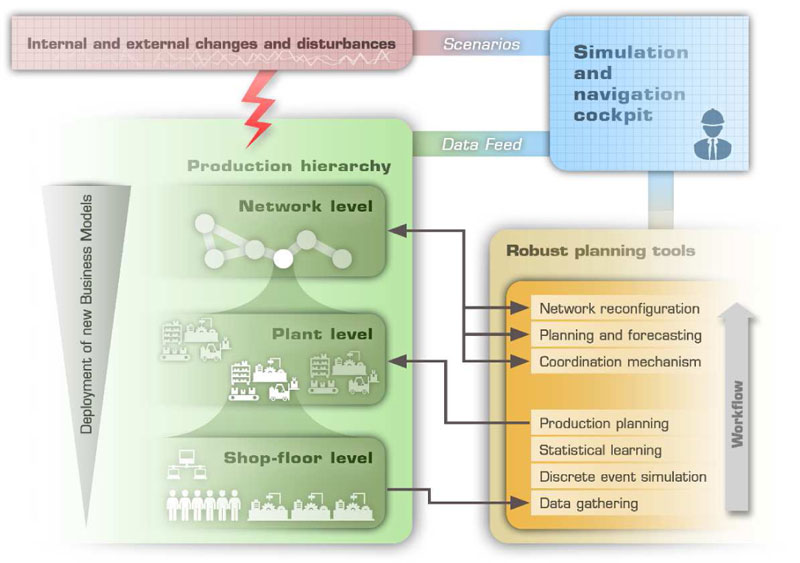by Péter Egri, Dávid Gyulai, Botond Kádár and László Monostori, SZTAKI
In today’s competitive manufacturing industry, efficient production planning is of crucial importance to match the supply with the customer order stream. The RobustPlaNet approach aims to support the decision makers at different hierarchical levels of production enterprises to react or even to proactively plan and manage their activities in a more robust way than it used to be in the traditional practice.
European manufacturing industry would benefit by transforming the current hierarchical supply chains into networks, based on partnerships with a new understanding of business approaches and services provided to the partners (B2B) and to the final customers (B2C). To this end, we investigated innovative decision-making methods that integrate production planning at single plants into the management of the whole global network. The research is funded by the European Union within the RobustPlaNet 7th Framework project, involving four academic and seven industrial partners from Hungary, Germany, Italy and The Netherlands.
Robustness aspects of production planning
In general, production planning methods rely on deterministic input data, hence fail to cope with the dynamic effects of the execution environment and the considerable uncertainty of the underlying planning information. Robust techniques that can provide feasible production plans are required to address these challenges. Robustness in production planning involves refined approaches that can handle predictable or unpredictable changes and disturbances, respond to the occurrence of uncertain events (reactive approaches) or protect the performance of the plan by anticipating uncertain events (proactive approaches) [1]. In our methodology, robust planning is the logical layer of the robust production. A production plan is considered robust if it achieves an acceptable level of the selected performance indicators even when unpredictable disruptions occur during the execution of the plan. The robustness of the system often works against other efficiency criteria, hence a trade-off is required if the objective is to increase system’s robustness. In the RobustPlaNet project, robust planning methods are defined both at the network and plant levels of the production hierarchy (Figure 1).

Figure 1: Robust planning methods of the RobustPlaNet project, defined at network and plant levels.
Planning in supply networks
The main goal on the network level is to enable robust and system-wide efficient production in a dynamic, unpredictable and global environment. Performance can be improved by implementing three complementary tasks. Firstly, the network design deals with configuration and re-configuration in order to provide a structure that is robust against diverse, largely unpredictable supply chain risks. Secondly, the supply chain planning matches supply and demand by considering statistically predictable fluctuations and disturbances. Finally, the coordination mechanism harmonizes the decisions made in a distributed manner, and supplements the risk management toolkit with risk sharing schemes.
The proposed methodology for supply network planning starts with identifying and analyzing the main sources of disturbances. Possible ways of managing these problems are then investigated, including estimated cost analysis. Owing to the complexity of a networked production system, the resultant alternative action plans are then evaluated in a multi-method simulation environment, enabling the combination of multi-agent, discrete event, and system dynamic modelling aspects in a general framework. This planning process will enable the network to respond to various circumstances, supporting efficient operations on the lower levels of the production hierarchy.
Robust production at the plant level
At the plant level in the production hierarchy, planning methods are aimed at calculating robust production plans that respect the possible uncertainties of a real production environment, maintaining the target level of key performance indicators, although disturbances occur during the execution of the plan. The robustness of the plans is provided by proactive, simulation-optimization approaches that mostly rely on near real time algorithms processing actual historical production data that is used in discrete-event simulation models to analyze possible future production scenarios. By applying statistical learning methods on the dataset provided by the simulation experiments, the outcome of future scenarios can be predicted analytically, even considering the stochastic parameters and random events that were represented in the simulation model. The prediction models are integrated into the mathematical optimization models that are responsible for calculating the robust production plans [2].
IT platform to support the planning activities
These novel planning tools and models are all integrated in a common software platform called Simulation and Navigation Cockpit. Each of the functional modules can be triggered independently directly from this platform which employs the modules as blackboxes in the background and offers an intuitive web-based GUI on role-basis. Additionally, the integrated platform allows the user to define custom, problem-specific workflow mechanisms where the modules are chained sequentially, each operating on the same database. Depending on the organizational requirements of a production company, different roles can be granted with different data access levels within the integrated platform, ensuring that users can only access data that they are permitted to.
This research is supported the by the European Union 7th Framework Programme Project No: NMP2013-609087, Shock-robust Design of Plants and their Supply Chain Networks (RobustPlaNet).
Links:
https://www.robustplanet.eu
https://www.linkedin.com/groups/8137114
References:
[1] T. Tolio, M. Urgo, J. Váncza: “Robust production control against propagation of disruptions” CIRP Annals-Manufacturing Technology, vol. 60, no. 1, 2011.
[2] D. Gyulai, B. Kádár and L. Monostori: “Robust production planning and capacity control for flexible assembly lines” IFAC-PapersOnLine, vol. 48, no. 3, 2015.
Please contact:
Botond Kádár
Fraunhofer PMI, SZTAKI, Hungarian Academy of Sciences, Hungary
Tel: + 36 1 279 6176











